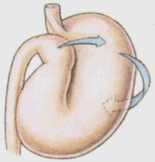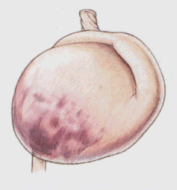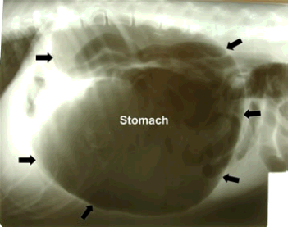Bloat is actually a misnomer. The correct term for the condition of the stomach filling with gas and rotating on its axis is called a gastric dilatation and volvulus (GDV). A gastric dilatation without volvulus (twisting) is technically a bloat. Dogs food bloat all the time - they get into the bag of cat food and eat all 20 pounds, and then they lie around and groan. That is a bloat. It is rarely life-threatening (although occasionally it can be). Somehow, the term bloat was applied to a GDV many years ago, and it has stuck. Most vets call a GDV a bloat, but at universities, you'll likely find sticklers who only say GDV.
At any rate, GDV occurs in large breed dogs such as Great Danes, Weimaraners, St Bernards, Doberman Pinschers, German shepherds, Labradors, and the like. No studies have been able to consistently identify a cause of bloating. There are many theories. Some believe that thin, nervous dogs that are fast eaters and gulp down a lot of air while eating are more prone to GDV. There has been no proof that this is the case. Others think it is strictly conformational - big, deep chested dogs. The truth is that no one knows what causes it. Some of the risk factors that have been identified are:
* Feeding only one meal a day
* Having closely related family members with a history of bloat
* Eating rapidly
* Being thin or underweight
* Moistening dry foods (particularly if citric acid is listed as a preservative)
* Feeding from an elevated bowl
* Restricting water before and after meals
* Feeding a dry diet with animal fat listed in the first four ingredients
* Fearful or anxious temperament
* History of aggression towards people or other dogs
* Male dogs are more likely to bloat than females
* Older dogs (7 - 12 years) were the highest risk group
The onset of a GDV is rapid, and a patient's condition can deteriorate in a matter of an hour. Once the stomach flips itself, gas, food, and fluid can no longer exit. The stomach rapidly dilates, leading to pressure on blood vessels that return blood from the rest of the body to the heart. Furthermore, the blood supply to the stomach is cut off, rapidly resulting in necrosis (death) of the stomach tissue. Shock rapidly sets in.




The signs of GDV are restlessness/pacing and discomfort, retching but not producing anything (or only producing a small amount of white foam), and a distended abdomen that sounds like a drum when you tap on it. These come on rapidly, and if noted, the patient should be taken to the ER immediately! In this case, minutes count!
Once you arrive at the ER, the technicians will likely whisk your pet away to the back immediately. Initial triage is the placement of an IV catheter, rapid infusion of large amounts of IV fluids to combat the shock, pain medications, and initial bloodwork. Once the patient is as stabilized as possible, a lateral xray of the abdomen will be taken. A GDV looks like this:

Surgery is absolutely the BEST treatment for a GDV. And FAST. Some veterinarians will pass a tube and can de-rotate the stomach that way. This method is fraught with problems. First, placing a tube into a twisted stomach is risky. If there is damage/death to the neck of the stomach (cardia), it is easier to accidentally puncture that neck. Further, if surgery is not conducted, it is impossible to tell how much damage has been done to the stomach. Lastly, if a patient does not undergo surgery and have the stomach de-rotated, a GDV is highly likely to happen again. In one study, at least 25% of dogs that did not have surgery were euthanized within 48 hours because of poor response to treatment.
As a sidenote, I recently saw a Great Dane that had a GDV. He presented to us, collapsed in the lobby, and proceeded to die. We were able to successfully resuscitate him, but after all that, his owners elected euthanasia. Afterwards, they casually mentioned to me that the dog had bloated before! but had not had surgery to correct it. The vet had passed a stomach tube and that was that. Had this dog had surgery, it is likely that I would never have seen him, and he would still be alive.
Surgery consists of de-rotating the stomach, passing a stomach tube and emptying out the contents, and then tacking the stomach to the body wall (gastropexy). If the stomach has suffered irreversible damage, then some of it might have to be removed.
Many people have the mistaken impression that a GDV cannot be fixed. This is not so! While it is a life-threatening emergency, rapid intervention and surgical repair can fix it. Rapid identification of the problem and surgery are absolutely imperative. Waiting 6 hours before deciding that a vet should be consulted is not a good idea.
Hospitalization after GDV repair can last for as little as 24 hours to as much as a week. My last 2 have spent about 36 hours hospitalized, then went home to live normal, happy lives. Complications can arise post-operatively, necessitating longer stays in the hospital. The whole process is also very expensive. Most dogs that we treat for GDV are 90 pounds or heavier. As a result, everything is more expensive. For surgery and post-operative care (in our hospital), a GDV will not run less than $1800-2500. As a result, we see many financial euthanasias. It's always sad, because a GDV is such a fixable problem.
*A special note about Great Danes. Some research indicates that as many as 1 in 4 Danes will bloat at some time in life. I highly recommend that all Great Danes undergo gastropexy (stomach tacking) as puppies. Especially females! It can be done while they are under anesthesia for a spay. It is important to remember that even though your dog has a pexy, it is possible that a GDV could still occur. Occasionally, these pexies break down! If a dog is pexied and exhibits signs of a GDV, it should be seen ASAP.







6 comments:
Just discovered your blog--looks very interesting! This is a great synopsis of GDV. I've been in practice since 2004 and have never had to do a GDV surgery. However, we routinely offer the option of stomach tacking/gastropexy for at-risk breeds when they are spayed (we offer it for the boys too, but it's easier to convince owners to make a bigger incision than a whole new incision).
One question for you.. I see "bloat kits" talked about everywhere on the net. They scare the bejeepers out of me. My though was if the stomach is twisted forcing a tube down, especially by someone not trained..
What's your take on them?
Learning: welcome to the blog! I was terrified when I did my first GDV (in my internship). Since then, I have come to love them. There is a lot of hype surrounding them, and I know lots of vets are scared to do them, but I think they're easier than a foreign body with an R&A by far! It's a comfort thing.
Elizabeth: That thought absolutely makes me SHUDDER. I don't actually pass a tube until I'm in surgery. Then, I can see the stomach, see if there is a lot of damage. If all looks good, I hold the cardia of the stomach in my hand while the anesthetist passes the tube, when I can feel it, I help guide it into the stomach.
On the other hand, if an owner came home and found the dog dying on the floor - sure, pass a tube and trocarize the stomach - in the car, on the way to the vet.
I fear too much time would be wasted screwing around blindly when getting to a vet should be the first task at hand.
Thanks HP I will be sharing that info I promise.. lots of doggy friend, you never know who you may help..
Bloat kit? Unbelievable, but Elizabeth is right; there are many articles, almost all written by breeders (German Shepherd, Great Dane, Swiss Mountain Dog, Borzoi, Mastiff, Newfoundland...)
I've seen plenty of NG tube disasters at the racetrack, thanks.
I have a very good friend who loves Danes. She's lost 3 of them to bloat, so now when she gets a new rescue in, while they are on the table for altering, they get tacked too. Boys AND girls.
As a lay person, I'd NEVER try to pass a tube.
Not.ever.
this is why I know my vets cell and home numbers and how to get to the ER.
Post a Comment